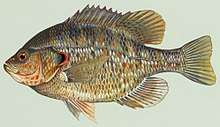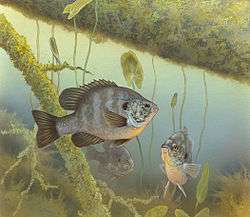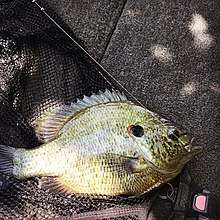Redear sunfish
The redear sunfish (Lepomis microlophus), also known as the shellcracker, Georgia bream, cherry gill, chinquapin, improved bream, rouge ear sunfish and sun perch) is a freshwater fish in the family Centrarchidae and is native to the southeastern United States. Since it is a popular sport fish, it has been introduced to bodies of water all over North America. It is known for its diet of mollusks and snails.
| Redear sunfish Temporal range: Middle Miocene to Recent | |
|---|---|
 | |
| Scientific classification | |
| Kingdom: | Animalia |
| Phylum: | Chordata |
| Class: | Actinopterygii |
| Order: | Perciformes |
| Family: | Centrarchidae |
| Genus: | Lepomis |
| Species: | L. microlophus |
| Binomial name | |
| Lepomis microlophus (Günther, 1859) | |
| Synonyms[2] | |
|
Pomotis microlophus Günther, 1859 | |
Description

The redear sunfish generally resembles the bluegill except for coloration and somewhat larger size. The redear sunfish also has faint vertical bars traveling downwards from its dorsal.[3] It is dark-colored dorsally and yellow-green ventrally. The male has a cherry-red edge on its operculum; females have orange coloration in this area. The adult fish are between 20 and 24 cm (7.9 and 9.4 in) in length. Max length is 43.2 cm (17.0 in), compared to a maximum of about 40 cm (16 in) for the bluegill. Lepomis microlophus averages at a size of about 0.45 kg (0.99 lb), also larger than the average bluegill. See an excellent representation of a trophy redear sunfish.
Habitat and range
Redear sunfish are native to North Carolina and Florida, west to south Illinois and south Missouri, and south to the Rio Grande drainage in Texas.[4] However, this fish has also been widely introduced to other locations in the United States outside of its native range. In the wild, the redear sunfish inhabits warm, quiet waters of lakes, ponds, streams, and reservoirs. They prefer to be near logs and vegetation, and tend to congregate in groups around these features. This sunfish is also located in many marsh wetlands of freshwater.
Diet
The favorite food of this species is snails. These fish meander along lakebeds, seeking and cracking open snails and other shelled creatures. Redears have thick pharyngeal teeth (hard, movable plates in its throat) which allow it to crunch exoskeletons. It is even capable of opening small clams. The specialization of this species for the deep-water, mollusk-feeding niche allows it to be introduced to lakes without the risk of competition with fish that prefer shallower water or surface-feeding. In recent years, the stocking of redear has found new allies due to the fish's ability to eat quagga mussels, a prominent invasive species in many freshwater drainages.[5]
Reproduction
During spawning, males congregate and create nests close together in colonies, and females visit to lay eggs. The redear sometimes hybridizes with other sunfish species.
Fossil record
The redear sunfish is the first-known species of Centrarchidae based on fossil records, as old as 16.3 million years, dating back to the Middle Miocene.
Relationship with humans
The IGFA all tackle world record for the species stands at 2.61 kg (5 lb 12oz) caught from Lake Havasu in Arizona in 2014.[6]
References
- NatureServe (2013). "Lepomis microlophus". IUCN Red List of Threatened Species. 2013: e.T202558A18230237. doi:10.2305/IUCN.UK.2013-1.RLTS.T202558A18230237.en. Retrieved 20 May 2020.
- Froese, Rainer and Pauly, Daniel, eds. (2019). "Lepomis microlophus" in FishBase. December 2019 version.
- Bosanko, David, and Dan Johnson. "Redear Sunfish." Fish of Michigan Field Guide. Cambridge, MN: Adventure Publications, 2007. 148-49. Print.
- Gilbert, Carter Rowell, and James D. Williams. "Redear Sunfish." National Audubon Society Field Guide to Fishes: North America. New York: Alfred A. Knopf, 2002. 347. Print.
- Tavares, Stephanie (2009-11-09). "Popular sport fish could solve Lake Mead's clam infestation". Las Vegas Sun. Retrieved 2009-11-20.
- "Sunfish, redear". igfa.org. IGFA. Retrieved 17 June 2019.
- Froese, Rainer and Pauly, Daniel, eds. (2005). "Lepomis microlophus" in FishBase. November 2005 version.
- Ellis, Jack (1993). The Sunfishes-A Fly Fishing Journey of Discovery. Bennington, VT: Abenaki Publishers, Inc. ISBN 0-936644-17-6.
- Rice, F. Philip (1964). America's Favorite Fishing-A Complete Guide to Angling for Panfish. New York: Harper Row.
- Rice, F. Philip (1984). Panfishing. New York: Stackpole Books. ISBN 0-943822-25-4.
External links
- GLANSIS Species FactSheet
 Trophy Redear are hard to find. Ken McBroom
Trophy Redear are hard to find. Ken McBroom
